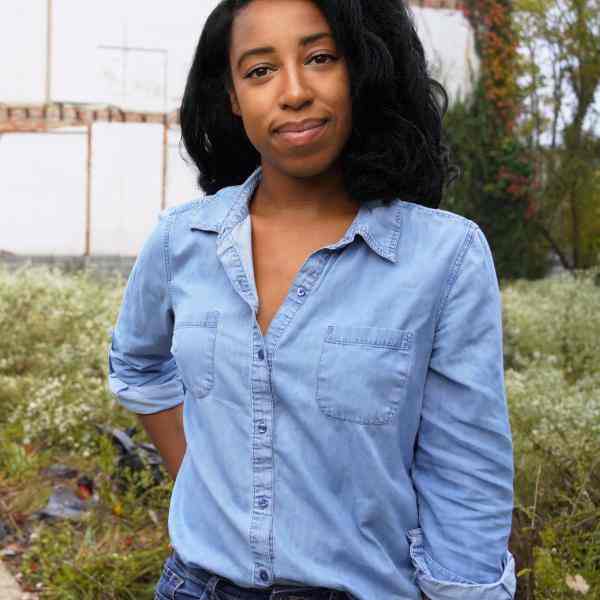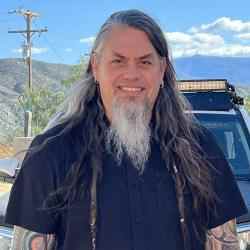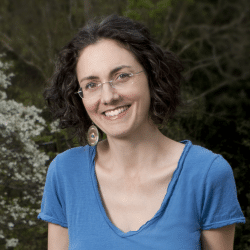Introduction
Bree Jones is turning abandoned structures within historically redlined neighborhoods into opportunities for Black homeownership and the revival of once-thriving Black communities.
The New Idea
Where many see problems, Bree sees opportunity. She believes that home ownership and social capital are required to restore Black wealth and heal the relationship that Black communities have with land and place. And she sees innate value in historically disenfranchised neighborhoods experiencing “hyper vacancy,” a dubious distinction bestowed on areas where more than one in five properties are vacant. Through Parity, the nonprofit she launched to champion this work, Bree turns the “issue” of hyper-vacancy into an opportunity to enable block-level development of affordable housing. While most developers court well-to-do individuals, Bree sees power in groups of aspiring first-time homebuyers. While most developers focus on affordable rentals, she’s focused on affordable home ownership. Where most developers focus on relatively stabilized neighborhoods to reduce risk, Bree works in the communities deemed “unredeemable” by traditional institutions. And where most development causes displacement, Bree’s approach makes sure that legacy residents stay put.
By charting her own way forward, Bree has modeled a powerful new way to increase home ownership and wealth among Black Americans and surfaces demand that other developers didn’t think was there. Parity recruits cohorts of aspiring homeowners, helps them access financing, and – with their collective commitment to buy and live in restored homes – Bree can then finance the rehabilitation of entire blocks of abandoned rowhouses in historically-significant Black neighborhoods. Bree is proving that this new, equitable, and more cost-effective model can create affordable home ownership opportunities in the most oppressed housing markets, not in spite of high rates of vacancy but, in a sense, because of the legacies of underinvestment and abandonment and the differently-shaped opportunities they make available today. She is proving that people still value these neighborhoods and in doing so, she's prompted a radical revaluing of Black neighborhoods by Black residents themselves (and financial institutions, too). Because it’s not just the bones of a house that give it value, it’s the way in which neighbors and the surrounding community make it a desirable place to live, and now whole groups of new homeowners can benefit from that value they themselves are creating.
Opportunities are unlocked on the supply side, too. Bree is outmaneuvering the systemic barriers that make the process of acquiring vacant buildings so difficult and costly, and she is working to change policy to make the process easier (for example, by dramatically reducing the time it takes to wipe tax liens from abandoned homes whose absentee owners have fallen behind on payments). In all this she’s proven that working at her particular pace and scale makes this endeavor cost effective for homebuyers, financial institutions, construction companies, and municipalities alike. As such, Parity’s model for leveraging Black home ownership and collective social capital as a foundation for wealth building and social justice has major implications for cities across the country, many of which have reached out to Bree for guidance as they see in her approach a solution to the challenges of affordable housing, hyper vacancy, and the persistent Black-white wealth gap.
The Problem
The term “redlining” has, in recent years, become shorthand for a wide array of race-based, exclusionary tactics in real estate that were designed to segregate communities and strip Black families of wealth and economic mobility. From real estate agents steering Black families toward certain communities and away from others, to predatory lending, to eminent domain, to covenants that barred Black families from certain suburbs and developments -- centuries of such practices created massive racial wealth disparities and gutted once healthy and thriving Black neighborhoods. The potency of these racist tactics shaped US cities, where Black families have low rates of home ownership and experience outsized housing insecurity.
Each American city has its own unique set of impediments to the creation of affordable housing. Baltimore, known colloquially as the “birthplace of redlining”, set a national precedent for discriminatory real estate tactics in the early 20th century and today bears the scar of this legacy in the more than 16,000 blighted and abandoned buildings in what is known as the “Black Butterfly” of East and West Baltimore -- once thriving majority-Black communities. In two of these neighborhoods (where Parity is currently working) more than a third of households are living below the poverty line; over a third of properties are abandoned; and only a quarter of homes are owned by residents (most of whom are elderly). There are no banks, no grocery stores, and 40% of households don’t have internet access. Moreover, 95% of residents are Black, highlighting Baltimore’s struggle with segregation and concentrated race-based poverty. High levels of vacancy further concentrate poverty and lock communities in a downward economic spiral.
Distressed neighborhoods like these typically follow two trajectories. In the first, the neighborhood is deemed unsavable. Continued disinvestment causes a deterioration of housing stock, which decreases quality of life and pushes people to move elsewhere. This signals to financial institutions that these places are risky and unredeemable. In the second, low-land values attract speculative developers who use predatory tactics to purchase and flip inhabited homes, displacing native residents and tilling the soil for rapid gentrification.
There are three major systemic barriers that make the redevelopment of neighborhoods like the “Black Butterfly” extremely difficult. The first and biggest barrier is the onerous process of acquisition: getting legal possession of abandoned buildings and vacant lots is incredibly laborious due to the accumulation of liens and lengthy foreclosure timelines. This alone can take 12-24 months, and back taxes can run 20 times the assessed value of the property. Because most cities lack the human and financial resources to shepherd this process, neighborhoods are abandoned until and unless a private developer comes along with the resources to invest. Second is the appraisal gap: even if someone did want to acquire and invest in a derelict building, based on current financing options and the cost of fixing one row house at a time, the cost of construction or rehabilitation is higher than the appraised value of the finished property, making bank loans impossible. And the third systemic challenge is the destruction of social fabric: when so many people have moved on, surviving heirs don’t even bother to claim the (complicated, deeply de-valued) properties of their deceased elders, thus interrupting and erasing the multi-generational accumulation of wealth.
As housing prices continue to rise in general, the challenges that historically red-lined neighborhoods face are being exploited by developers, and a new barrier emerges: an “affordability gap.” Because abandoned housing stock is so time and labor intensive, private, profit-driven developers tend to target houses that are occupied – often by Black elders – and vulnerable to cash-buys and other predatory practices that undervalue their homes. The developers then make relatively minor improvements and sell the homes at inflated prices that are completely out of reach for low-to-moderate income legacy residents, which inevitably leads to displacement and housing instability for the city’s most vulnerable. Alternatively, the developers may split the houses into micro-apartments and remove yet another ownership opportunity from the housing supply.
Because of these complex systemic barriers, U.S. cities have not succeeded in achieving deep affordability in home ownership and rental options.
The Strategy
Bree’s gift, and the reason she’s been able to increase affordability and create pathways to Black home ownership, is her ability to unearth opportunities where others see intractable problems. With this keen eye for potential and a deep-set belief in the possibility of “development without displacement,” Bree is outsmarting and outmaneuvering traditional development models and changing policies that uphold barriers to Black thriving and economic mobility.
She has focused on and recast each of the systemic barriers described above. Yes, the process of acquiring and then rebuilding abandoned houses is long and laborious, but speed biases well-to-do homebuyers and profit-driven investors. Bree’s approach entails strategic patience and turns this long runway to her advantage, both in terms of eventual property acquisition as well as the deep engagement with and among cohorts of aspiring homebuyers that a more spacious timeline makes possible.
What about the appraisal gap? Yes, the cost of restoring these homes can be far more than they appear to be worth on paper, especially when the total lien amounts are factored in. But Bree is able to tap into historic preservation funds (usually only accessed by wealthy White property owners), astutely navigates Baltimore City tax codes, and even attracts some philanthropic funding to dramatically lower costs. She also helped pass Appraisal Gap legislation in the Maryland State Senate that creates a vehicle for the State to provide subsidy funds to mission-aligned developers to create affordable homeownership opportunities for low-to-moderate income homebuyers.
And the frayed social fabric? Blocks of beautiful, refurbished owner-occupied historic rowhouses become the metaphorical warp, the length-wise yarns in a textile that provide a stable structure around which the transverse weft of new homeowners and engaged neighbors weave in and out.
Bree decided to start in West Baltimore, an area that was once home to a vibrant, large and economically diverse Black community before controversial “urban renewal” policies and the construction of the highway led to massive displacement. Today the 12-block area is “hyper vacant” and behind the stately facades, inner walls and floors have collapsed, with trees reclaiming foundations. Parity has since acquired 30 properties and 42 tax liens of abandoned and vacant property in their development footprint. They are on track to acquire 50 more by the end of 2023, with the first cohort of residents moving into their homes in the winter of 2022.
When it comes to working capital to start refurbishing the houses, Parity can access construction loans because they can demonstrate they have buyers lined up. Their innovative approach is to pre-sell entire blocks of abandoned properties to pre-existing social networks, rather than attempting to sell a single renovated building on a mostly abandoned block. Renovating adjacent rowhouses at the same time also helps lower the overall construction costs.
While construction is underway to restore the acquired structures, each cohort of aspiring homebuyers goes through a six-month curriculum that prepares them for homeownership and deepens their relationship to one another and their new neighborhood. The curriculum involves financial literacy training, credit repair, support in accessing bank financing, and even Pinterest vision boards to help in choosing light fixtures, paint colors, and trim packages, all of which shores up the new and profoundly empowering identity of “homeowner.” They also learn about the traumatic history of redlining in Baltimore and envision, as a collective, how to cultivate a healthy place to live. Parity partners with HUD-approved homeownership counselor, Neighborhood Housing Services, and preferred lenders like Bank of America to qualify and approve homebuyers for mortgages. When the six months are up, cohort members have formed deeper relationships with one another, are invested in the power of the “collective” and are financially prepared to own and manage a home.
Then comes the real draw: they get to become neighbors by buying homes at the same time, on the same block. “We use collective economics to reduce any one individual’s risk, while deepening the human bonds that make community,” says Bree. “If we have 30 homeowners who all move onto a block at one time, that radically changes the dynamic of a distressed area.” To-date, all cohort members have joined via word of mouth, and there is currently a waitlist of over 400 people. As these neighborhoods increase in desirability and value, Parity ensures that legacy residents are able to participate in and benefit from reinvestment. One mechanism is the Stop Oppressive Seizures (or SOS) Fund, a co-creation of Parity, Fight Blight Bmore, and Maryland Volunteer Lawyer Services, which uses housing stability measures to mitigate loss. As of 2022, the fund has successfully advocated for the removal of over 2,900 people from the city’s annual tax sale and prevented a number of investors from buying up debt and throwing people out on the street.
Bree has built Parity to operate as a developer, community organization, and an advocacy group (very few organizations do all three). Regarding the latter, while Bree has embraced the long delays and even makes lemonade of incoherent real estate policies, she also advocates for systemic solutions that will pave the way for other value-aligned developers and future homeowners, in Baltimore and beyond.
For example, she authored and helped to pass a Maryland State bill to address the appraisal gap issue. She has supported the creation of a land bank, a quasi-government, community-informed agency that can expedite the process of acquiring vacant and abandoned properties. The legislation they are working on currently would reduce the acquisition time from 12 to 6 months and process 2,000 buildings per year – solving the issue of hypervacancy in Baltimore within the decade.
In five years, Bree aims to restore 200 homes per year in Baltimore while sharing and witnessing the model be adopted in cities around the country. It is no surprise that Parity is already gaining national recognition as a pioneer in creating housing supply and homeowner demand in forgotten, disenfranchised neighborhoods. Bree has shared her insights and learnings in local press, with the affordable housing sector, and most recently on the TED stage. She doesn’t miss an opportunity to talk about the role of social capital in proving that there is indeed a thriving market where many saw ‘ruin’. And she sees Baltimore as an important citadel for a new equitable development and affordable housing playbook that could be relevant for any city in the U.S., especially those dealing with hyper vacancy, such as Chicago, Cleveland, and Detroit.
As Bree puts it, “Parity is healing the relationship that Black communities have with land and place by restoring the ownership that was systematically stripped through institutionalized racism, fostering dialogue about this traumatic history while also holding space for the envisioning of healthy thriving spaces, and reigniting the agency for community members to dictate how their neighborhoods are designed. Parity is closing the racial wealth disparity, creating pathways for multigenerational wealth transfer, and as a result of housing stability, increasing resident’s agency and ability to live full, self-determined lives.”
The Person
Bree grew up in the Bronx, NY and New Rochelle, NY. Her deep curiosity and desire to learn from others took her all over the world at a young age; in China she became fluent in Mandarin, in Cape Town she applied her business expertise to support local women working on the issue of food deserts in shantytowns. During college she gathered together hundreds of students to teach and learn over 50 languages as the president of the school’s language club.
Bree graduated from college the same year that Trayvon Martin Jr. was murdered and his murderer acquitted. Outraged and grieving, she joined a grassroots racial justice organization in her hometown of New Rochelle where she finally gained the language to describe dynamics that she had been experiencing her entire life, including learning about race-based policies like redlining. That same year, a development corporation purchased several parking lots in the majority Black and Brown downtown of New Rochelle, with plans to erect 2,000 luxury apartments. Bree helped mobilize community members to advocate for a community benefits agreement that demanded affordable housing, local hire, and living wages on all properties being built. Their group had some small wins, but by and large the developer steamrolled the community. The project set in motion rapid gentrification and today, the neighborhood is almost unrecognizable and most of the people who lived here have been forced out.
Meanwhile, Bree had started her career on Wall Street at Morgan Stanley, and within a few years, became the youngest and first Black female Vice President at a $12B hedge fund, then transitioned to a venture capital firm where she was an early-stage investor in financial technology startups.
All of these concurrent experiences –grieving and activating in community, witnessing the blunt force of gentrification, and learning the ins and outs of financial markets and investing– got Bree to thinking; can we exist in an economic system that doesn’t rely on a zero-sum outcome? Bree had been saving money towards a down payment on her first home. But as she watched rental prices in her neighborhood skyrocket, she decided to preserve affordable rentals instead. She bought an abandoned three-family house and did a complete renovation. To this day, there are three working class families living there, paying well-below-market rents.
She built Parity in response to an oppressive system that was designed to extract wealth from Black communities. After studying and road-tripping through cities across the east and Midwest, Bree fell in love with Baltimore and decided that the “birthplace of redlining” was where she would try to pilot her idea. In 2018, Bree quit her job and moved down to Baltimore with a suitcase in-hand. When she first pitched her idea to a room of developers, they laughed her out - called it “impossible." Within three short years, Bree has emerged as a leader in her new hometown with avid supporters from all walks of life. She is proving that “development without displacement” is not only possible but perhaps the path forward for cities across the U.S.




